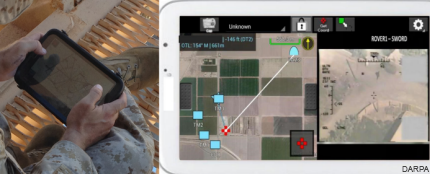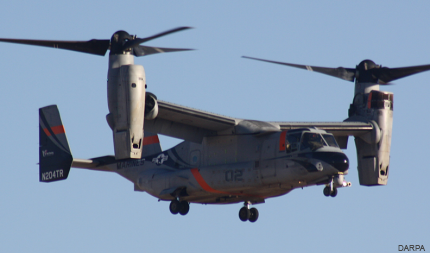Marines, DARPA show what real-time air support looks like
The prototype Persistent Close Air Support System dramatically cuts the time from identifying a target to delivering a strike.

Marine forces used the KILSWITCH tablet to identify a target and communicate its position.
Military researchers and Marines recently demonstrated just what they mean when they talk about “real-time situational awareness,” with a successful test of the prototype Persistent Close Air Support System.
Close air support—the delivery of bombs or other munitions to protect and assist ground forces—has long been a key tactic for the military. But even under the best of circumstances, the current system of relying on paper maps and voice instructions can take a half-hour or more to deliver support. On March 27 at the Marine Corps’ Talon Reach training exercise, ground forces using an Android tablet identified a target and sent its position to an MV-22 Osprey, which fired a (non-explosive) precision-guided Griffin missile from 4.5 miles away, hitting exactly where it was supposed to.
Total elapsed time: just over four minutes, well under the goal of six minutes.
The test was the first successful integration of the full PCAS prototype, which uses digital data links and advanced software to tie together ground controllers, aircraft and munitions in a system being developed by the Defense Advanced Research Projects Agency, the Marines and a contractor team led by Raytheon, with assists from other military research centers.
DARPA offers a quick look at the demonstration in the dramatically scored video below.
“I am very pleased with the successful PCAS demonstration that we had during Talon Reach," Lt. Gen. Jon M. Davis, the Marine Corps’ deputy commandant for aviation, said in a DARPA release. "I have emphasized to my team that we will network every one of our aircraft."
The big step forward in the project was integrating an air component with a ground component that has already been in use. Marines began using their version of PCAS-Ground—which they call Kinetic Integrated Low-cost SoftWare Integrated Tactical Combat Handheld, or KILSWITCH—in Iraq and Afghanistan starting in 2013. PACS-Ground is a suite of situational awareness and mapping software, developed with the Naval Air Warfare Center and the Air Force Research Laboratory, hosted on Android tablets. Since DARPA introduced the tablets, the Marines have employed thousands of them and have documented better navigation, situational awareness, fire coordination and communications because of them, DARPA said.
At Talon Reach, the team incorporated PCAS-Air, a combination of weapons management, ISR and communications systems, on a Smart Launcher Electronics (SLE) device with a modular design that allows it to work with almost any aircraft.
“On its first try, the full PCAS prototype system showed we could use a modular, system-of-systems approach to adapt an aircraft to provide close air support, and deliver that capability via real-time coordination with ground forces,” DARPA program manager Dan Patt said. “The successful tests point the way to a new model in which the addition of close air support, communications and live ISR support functions to any aircraft would be straightforward, and ground forces would have on-demand access to situational awareness data, modern network-enabled communications and a synchronized digital model of the evolving battlefield.”

An MV-22 Osprey with a PCAS-Air component delivered the strike.
On the heels of the Osprey demonstration, DARPA said it work on using the system with unmanned aircraft with another service partner and is planning flight demonstrations using a U.S. Air Force A-10 Thunderbolt II attack aircraft.
DARPA kicked off the PCAS program in 2011, with a $7 million award to a Raytheon team for work on Phase 1. The team worked on maturing the technology during a 12-month Phase 2, before Raytheon started on Phase 3 under an 18-month, $25.5 million contract. Flight tests for PCAS began in November 2014.
In all, the project developed pretty quickly, particularly the demonstration of the full PCAS prototype. “Thanks to the excellent collaboration between DARPA, the Marine Corps and the performers supporting this activity, we were able to conduct a successful demonstration from a standing start in less than 120 days,” said Brad Tousley, director of DARPA’s Tactical Technology Office.
Along with Raytheon, contractors on the project include Bell Helicopter and Rockwell Collins, with system elements from Kranze Technological Solutions, L-3 Wescam and AeroVironment.